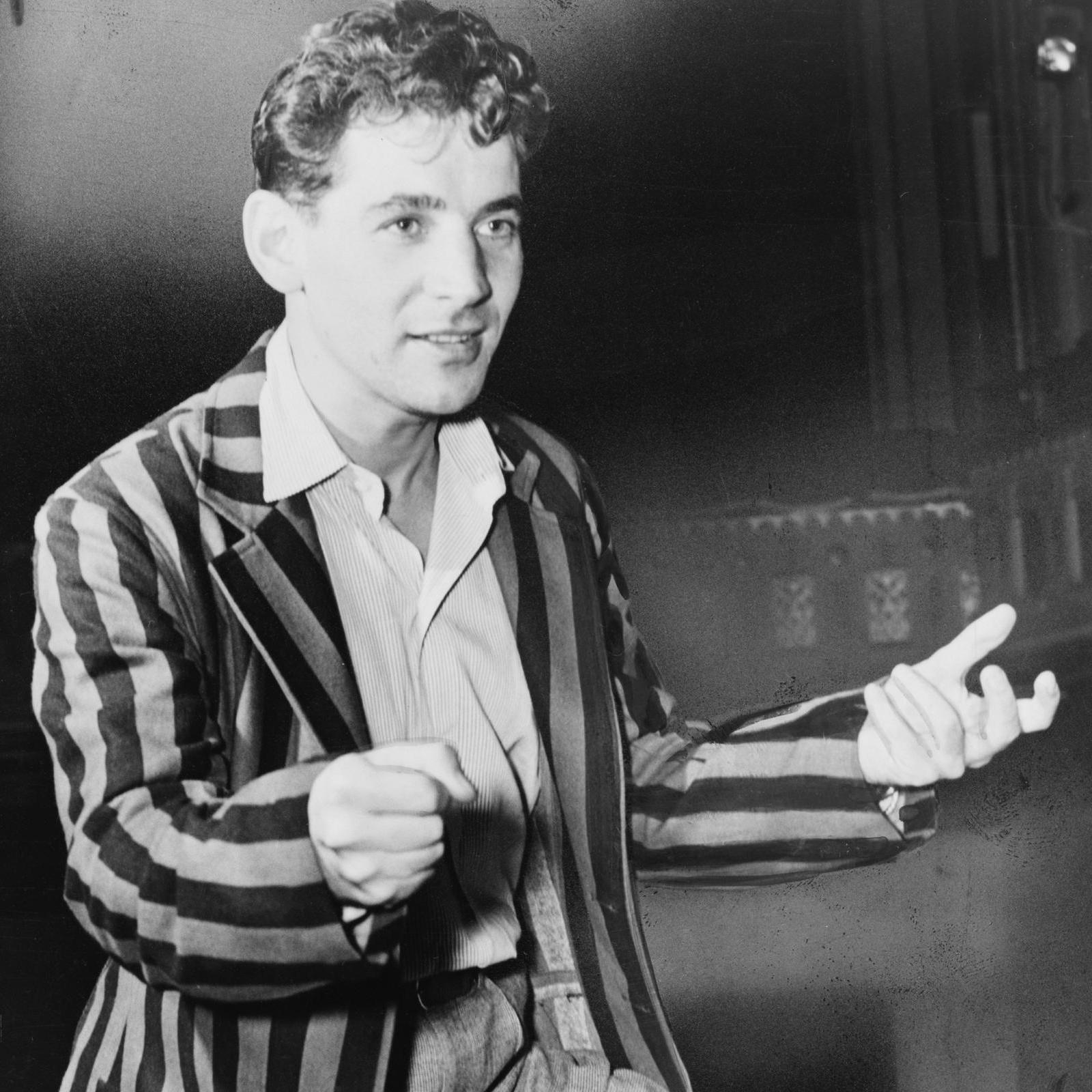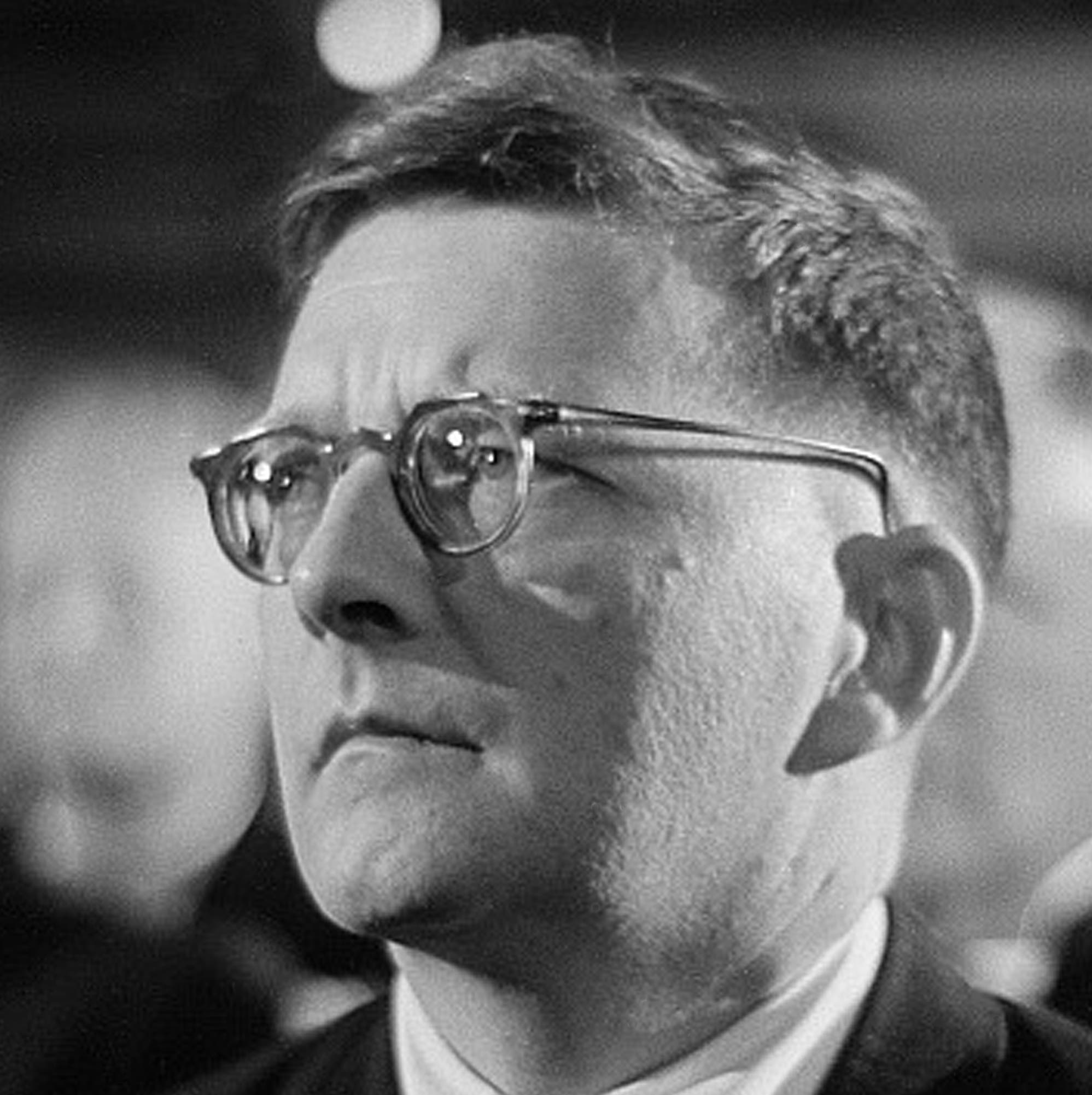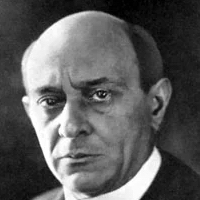Madison Symphony
Orchestra Program Notes
October 20-21-22, 2023
98th Season /
Subscription Program 2
J.
Michael Allsen
Our
second
concert features the Madison Symphony Orchestra’s
“power couple:” the
husband-wife team of associate conductor Kyle Knox
and concertmaster Naha
Greenholtz. Mr. Knox has led the orchestra in
Overture Hall several times, but
here he makes his debut conducting one of our
subscription concerts. Ms.
Greenholtz is making her sixth appearance as a
soloist at these concerts, previously
performing the Mendelssohn Violin
Concerto
(2013), Bernstein’s Serenade
(after
Plato’s Symposium) (2015), Corigliano’s Chaconne
from “The Red Violin” (2016), the Prokofiev
Violin Concerto No. 2, and the Haydn
Violin Concerto No. 4 (2022). Here she
plays a formidable 20th-century work:
Shostakovich’s challenging Violin
Concerto No. 1. This program also includes
two works never played by the MSO,
opening with music from Bernstein’s 1944 ballet
score Fancy Free. After intermission, the
orchestra plays a well-known
chamber work by Brahms...in a fascinating
orchestration by Arnold Schoenberg.
 The
ballet Fancy Free, written as Bernstein was
just coming to national
prominence, was his first collaboration with
choreographer Jerome Robbins, a
partnership that would also lead to the phenomenally
successful Broadway shows On The Town
and West Side Story.
The
ballet Fancy Free, written as Bernstein was
just coming to national
prominence, was his first collaboration with
choreographer Jerome Robbins, a
partnership that would also lead to the phenomenally
successful Broadway shows On The Town
and West Side Story.
Leonard
Bernstein
Born:
August 25,
1918, Lawrence, Massachusetts.
Died:
October 14,
1990, New York City, New York.
Three Dance Variations from “Fancy Free”
•
Composed:
1943-44.
•
Premiere:
April 18, 1944, at the
Metropolitan Opera in New York City. Bernstein
extracted the Three Dance
Variations as a concert piece shortly
afterwards.
•
Previous MSO
Performances: This is our first performance of
the work.
•
Duration:
7:00.
Background
The ballet tells the story of
three
sailors on shore leave, and the music heard here
comes from a “competition”
they stage in a bar, for the attention of two young
women.
The prodigiously talented
Leonard Bernstein could have had any one of several
successful careers: piano
soloist, classical composer, conductor, writer,
lecturer, or Broadway
songwriter. In fact Bernstein chose to do all
of these things and to do
all of them very well! At age 25, he was named
assistant conductor of the New
York Philharmonic, and his legendary “big break”
came on November 14, 1943,
when with just a few hours’ notice he substituted
for Bruno Walter in a
nationally-broadcast concert from Carnegie Hall.
Shortly before this famous
broadcast, Bernstein was approached by dancer Jerome
Robbins. Unlike Bernstein,
who was already a star, Robbins was still
up-and-coming, but he was every bit
as ambitious. He wanted Bernstein to write a score
for his Fancy Free—his first ballet, to be
performed by the Ballet Theater
of New York. The two hit it off immediately, and
Bernstein immediately began
work on the ballet’s score.
The original inspiration
for the story was a pair of paintings by the New
York artist Paul Cadmus, The Fleet’s In!
and Shore Leave. These were energetic and
popular images of sailors on
leave, though the frank sexuality of Cadmus’s works
was sometimes
controversial. The scenario for the ballet involved
three sailors on shore
leave on a hot summer night. They meet a pair of
girls in a bar, and begin to
fight over which of them will be the odd man out.
They stage a kind of
competition, each of them dancing a solo designed to
impress the girls, but in
the end both girls lose interest and walk off.
Though Robbins created the
choreography using the vocabulary of Classical
Ballet, there are also hints of
the dances that were current in ballrooms and bars
across America: the Shag,
the Lindy Hop, and the Jitterbug. Bernstein’s score
was every bit as much a
blend of the ballet and popular music. Fancy
Free was a great success, making Robbins a
celebrity and increasing
Bernstein’s fame as a composer. Later in 1944, the
pair collaborated again on a
full-scale Broadway show, On the Town.
This show, which expands on the story of Fancy
Free (though with entirely new music), would
be a huge hit, and, in 1949,
an Oscar-winning film.
What You’ll
Hear
The Dance
Variations
include an energetic Galop, an
offbeat Waltz
and a relaxed Danzon.
This
brief set of three dances comes from the climactic
competition scene at the end, as the sailors try to
decide which two of them
will get to go with the women. This is an early and
completely lighthearted
version of the kind of aggressive music Bernstein
would later write for violent
scenes in On
the Waterfront and West Side
Story. The Galop is
frantic and macho, while the Waltz, with
its oddly dropped beats, is
danced by a sailor who has obviously had a bit too
much to drink. The final
section, Danzon,
is a Latin-flavored
number with hints of the Mambo, a dance that was
just starting to become
popular in New York City ballrooms.
 This concerto was inspired by the
great Soviet violinist David
Oistrakh (1908-1975), a friend of Shostakovich, and
a musician whom the
composer deeply admired. He would compose a second
violin concerto for Oistrakh
in 1967.
This concerto was inspired by the
great Soviet violinist David
Oistrakh (1908-1975), a friend of Shostakovich, and
a musician whom the
composer deeply admired. He would compose a second
violin concerto for Oistrakh
in 1967.
Dmitri
Shostakovich
Born:
September
25, 1906, St. Petersburg, Russia.
Died:
August 9,
1975, Moscow, Russia.
Violin Concerto No. 1 in A minor, Op. 99
•
Composed:
1947-48.
•
Premiere:
A slightly revised version
was premiered by David Oistrakh on October 29, 1955
in Leningrad (St.
Petersburg), with the Leningrad Philharmonic, Evgeny
Mravinsky conducting.
•
Previous MSO
Performance: 2011, with violinist Midori.
•
Duration:
35:00.
Background
This was
one of several works that Shostakovich composed and
suppressed during the repressive regime of Stalin.
It remained unperformed for
some seven years, finally premiering two years after
Stalin’s death.
Shostakovich
often skirted the edge of official disapproval
in Stalinist Russia. Directly after World War II
ended, his ninth symphony got
him in trouble for failing to deliver the expected
glorification of Stalin and
the great Soviet victory, and for the next few
years—the period in which he
wrote the Violin
Concerto No.1—he was
under increasing official suspicion. Shostakovich
and several other prominent
Soviet composers were officially censured in 1948,
in the wake of the “Zhdanov
Doctrine,” a wide-ranging attempt to mold Soviet
culture. Shostakovich was
censured for the “formalist” elements of his
music—“formalism” being anything
that smacked of Western European modernism or
complexity. (In practice, the
term seems to have meant just about anything a
critic wanting to censure a
composer wanted
it to mean.) Not
surprisingly, Shostakovich suppressed some of his
more ambitious postwar
works—notably the concerto and the fourth string
quartet—though he continued to
write works in an uncompromisingly modern style in
private. His “public” face
over the next few years was that of a good Soviet
citizen, writing politically
“safe” works like film scores and hyper-patriotic
cantatas.
Stalin
died in 1953 and the political climate for Soviet
artists began to thaw relatively quickly. The Violin Concerto was one of a few
suppressed works that made their
appearance when Stalin was still relatively warm in
his tomb. It was quite
successful at its premiere in Leningrad in 1955, and
David Oistrakh—who would
tour extensively with the concerto, and make two
famous recordings of
it—described the solo part as a “pithy
‘Shakespearian’ role.”
The concerto is hardly an overtly
“political” work, but there are
several elements that point to an autobiographical
or political awareness in
the piece. Shostakovich may have seen Russian Jews
and Jewish music as symbols
of resistance to oppression—at least this is what
comes through in a discussion
of the concerto in his “memoir” Testimony.
While this book remains controversial in some
quarters, the influence of Jewish
music, particularly in the scherzo, is clearly
there. This is
also one of the first appearances of
Shostakovich’s
personal musical motto—the DSCH motive. (This
takes a little explanation... In
several of his late works, Shostakovich used a
four-note motive—D, E-flat, C,
B—as a kind of signature. Here he was spelling the
German version of his
initials: Dmitri
SCHostakowitsch
[“sch” would be a
single character in the Russian alphabet]. “D” is
the pitch D, “S” becomes
E-flat for the German abbreviation for that pitch,
“C” is the note C, and “H”
is the German abbreviation for the pitch
B-natural.) There are also references
to the of the “Stalin Theme” from his own seventh
symphony, and the so-called
“Fate” motive of Beethoven’s fifth.
What You’ll Hear
The
concerto is laid out in four movements:
• A lyrical
Nocturne.
• A
fast-paced and aggressive Scherzo,
that pits the soloist against the orchestra.
• An
emotional Passacaglia:
a set of variations above a repeating bass pattern.
This movement ends with an
extended solo cadenza that leads directly into the
finale.
• A
forceful Burlesca,
filled with witty references to the earlier
movements and to other music.
The concerto is built in
symphonic
form, with four movements, opening with a calm Nocturne (Adagio). This is almost
uninterrupted violin melody that
grows out of a few ideas heard in the opening.
Though the sections in this
quiet night music are hazily defined, it moves
gradually towards a moment of
muted power near the end before subsiding quietly. The Scherzo
(Allegro non troppo) is a fierce and
sometimes satirical contrast, as the
violin is placed in opposition to the orchestra
throughout, sometimes taking an
accompanying role and sometimes playing raucous
peasant tunes above a robust,
rhythmically uneven background.
The Passacaglia (Andante) adopts the old
Baroque form, a repeating bass
line that serves as the basis for a
constantly-developing set of variations.
Despite the rather strictly-defined form, this
movement contains some of the
concerto’s most passionate music for the violin,
often in gentle counterpoint
with solo lines from the orchestra. The bass line
eventually fades away,
leaving the violin alone for a huge and
emotionally intense cadenza, extending
over more than a third of the movement, and
serving as a bridge into the final Burlesca
(Allegro con brio). This wild
movement, which includes a few nods to Stravinsky,
gives the orchestra some
wonderfully quirky music and some real fireworks
for the soloist, while working
in sly references to the earlier movements.
 Brahms completed this
work, one of his finest
early chamber pieces, in 1861. Schoenberg wrote his
orchestral version in 1937
for a commission by Otto Klemperer.
Brahms completed this
work, one of his finest
early chamber pieces, in 1861. Schoenberg wrote his
orchestral version in 1937
for a commission by Otto Klemperer.
Johannes
Brahms
Born: May
7,
1833, Hamburg, Germany.
Died:
April 3,
1897, Vienna, Austria.
Piano Quartet in G
minor, Op. 25 (orchestrated
by Arnold Schoenberg)
•
Composed:
1861; Schoenberg’s orchestral version dates from
1937.
•
Premiere: May 8, 1938, with the
Los Angeles Philharmonic, Otto Klemperer
conducting.
•
Previous
MSO Performances: This is our first
performance of the work.
•
Duration:
43:00.
Background
There are
many pieces in the orchestral repertoire that are orchestrations:
works for keyboard or
chamber ensemble that were later adapted for
orchestra. These works can sometimes
have a different impact than the smaller original.
(Famous examples include the
wonderful Ravel orchestration of Mussorgsky’s piano
suite Pictures at an Exhibition, and the
full orchestra version of Copland’s
Appalachian
Spring we performed at
our last concert.) In this case, we have a
19th-century romantic chamber work,
orchestrated with a distinctly 20th-century
character.
Brahms’s Op.25—one of two
piano quartets he composed
in 1861—was one of the early works with which he
first made his reputation as a
composer. Though his first symphony was still 16
years in the future, these
quartets were “symphonic” in size and scope, if not
in instrumentation, particularly
the impressive G minor quartet. The work was a
success when it was premiered, with
Clara Schumann at the piano, in his native Hamburg.
A year later Brahms moved
to Vienna, where he would remain for most of the
rest of his life. With Clara
Schumann’s strong recommendation proceeding him, he
quickly made friends in
Viennese musical society. In need of an impressive
debut as both a composer and
a pianist, Brahms programmed the G minor quartet for
his first public
performance in Vienna, with members of the famed
Hellmesberger Quartet taking
the violin, viola, and cello parts. The piece,
particularly the Gypsy-style
finale, became a favorite in Vienna, and Brahms
played it many times over the
next few years.
Let’s skip ahead over seven
decades. In 1933, Arnold
Schoenberg (1874-1951) was comfortably employed as a
composition teacher at the
Art Academy in Berlin. When the Nazi government
announced its intention to
remove all Jews from positions of authority,
Schoenberg promptly fled to
France, and soon afterwards to the USA. He settled
first in Boston, but on the
advice of doctors, he moved to Los Angeles in 1934
for the sake of the climate.
He eventually took a professorship at UCLA, and
would spend the rest of his
life in Los Angeles. American audiences had little
interest in Schoenberg’s original
compositions but in 1937, he received a commission
from fellow refugee Otto
Klemperer—then conductor of the Los Angeles
Philharmonic—to orchestrate the
Brahms Piano Quartet. Schoenberg was
delighted: he was a lifetime
admirer of Brahms’s music, particularly of its
intense thematic development. When
his arrangement was premiered in 1938, Schoenberg,
never one for modesty, described
it as Brahms’s “fifth symphony.” A year later, he
described in a letter the
attraction of the piece and his intentions in a
laconic series of “bullet
points:”
“My reasons: 1. I
like
the piece. 2. It is seldom played. 3. It is always
very badly played, because,
the better the pianist, the louder he plays and you
hear nothing from the
strings. I wanted once to hear everything, and this
I achieved.
“My intentions: 1.
To
remain strictly in the style of Brahms and not to go
farther than he himself
would have gone if he lived today. 2. To watch
carefully all the laws to which
Brahms obeyed and not to violate them, which are
only known to musicians
educated in his environment.”
What You’ll
Hear
This work is in four movements:
• A long and rather intense Allegro
in
sonata form.
• A gentle Intermezzo.
• A lyrical slow movement that includes a
surprisingly martial episode.
• A wild Gypsy-flavored finale.
Arnold Schoenberg
 Schoenberg’s
arrangement parcels out the busy
original piano part and the three string parts to a
full orchestra, and a
percussion section that includes xylophone and
glockenspiel. Despite his
implication that there was nothing that Brahms
himself would not have written in
this “fifth symphony,” there is a lot of Schoenberg
here—every note, rhythm,
and harmony that appears in this version is from the
original, but Schoenberg’s
fingerprints are all over the lavishly-orchestrated
finale, and the way that he
emphasizes Brahms’s more chromatic harmonies.
Schoenberg’s
arrangement parcels out the busy
original piano part and the three string parts to a
full orchestra, and a
percussion section that includes xylophone and
glockenspiel. Despite his
implication that there was nothing that Brahms
himself would not have written in
this “fifth symphony,” there is a lot of Schoenberg
here—every note, rhythm,
and harmony that appears in this version is from the
original, but Schoenberg’s
fingerprints are all over the lavishly-orchestrated
finale, and the way that he
emphasizes Brahms’s more chromatic harmonies.
The lengthy opening movement
(Allegro) is in
sonata form, and explores no fewer than five
distinct themes ranging in
character from the solemn opening figure to a pair
of brighter major-key ideas.
These themes are worked out in a vast development
section: a musical drama
intensified by Schoenberg’s imaginative
orchestration. After all of this of
this drama, the Intermezzo is a bit of
relief, though Schoenberg
highlights the musical uneasiness underneath
Brahms’s placid themes. Though
there are moments of outward tension, most of this
movement is gentle and even
playful. The third movement (Andante con moto)
is based upon a broad romantic
melody, lushly orchestrated by Schoenberg. There is
a march-style episode at
the center that Schoenberg turns grandiose with
snare drum and brass.
Roma/Gypsy music was all the
rage in Vienna in the
1860s, and Brahms’s finale (Rondo alla zingarese
— “Rondo in Gypsy
Style”) was the most popular part of his G minor
quartet. Brahms had learned
the style a decade earlier, when he toured as
accompanist to the Hungarian
violinist Ede Reményi, and used it brilliantly here.
This Rondo is based
upon a lively main theme (that Schoenberg
accentuates with tambourine) alternating
with contrasting material. Everything in this
movement has the distinctive
rhythmic style and passion of Gypsy music, and
Schoenberg assigns some
particularly tasty bits to the solo violin and
clarinet. At the end, everything
accelerates to wild conclusion.
________
program notes ©2023 by J.
Michael Allsen